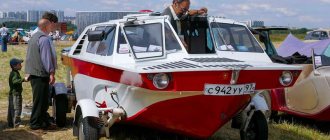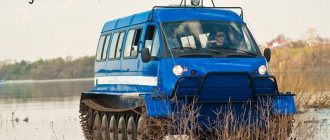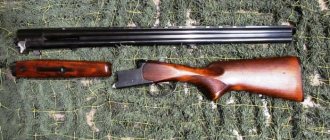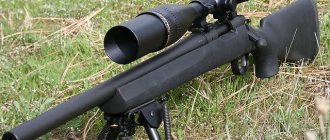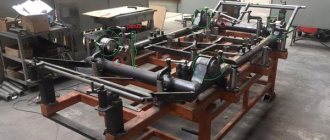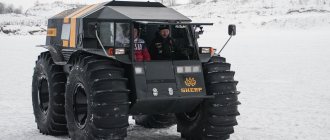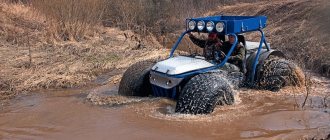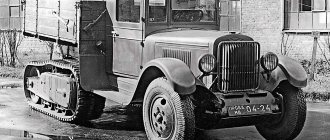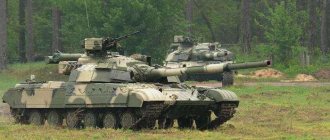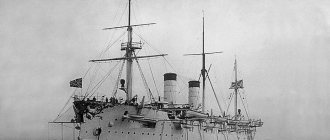The Sherpa all-terrain vehicle is a floating SUV that is equipped with ultra-low pressure tires. Production is carried out at the enterprises of 2 companies in Ukraine and Russia, and the idea of the machine belongs to designer Alexey Garagashyan. The model has gained popularity among hunters, fishermen and those people who are forced to overcome difficult sections of the route and work in unfavorable climatic conditions.
Who invented Sherpa: the history of the creation of the all-terrain vehicle
The development of the Sherpa all-terrain vehicle started 8 years ago. The main part of the concept was invented by self-taught designer and traveler Alexei Garagashyan, who has been designing all-terrain vehicles for many years and taking part in sports competitions in America.
The model that Garagashyan invented is the implementation of the professionalism, experience and original ideas of the creator. Due to the high cross-country ability, the vehicles travel freely through swamps, snowy areas and water bodies.
The public presentation took place in 2015 at the Moscow Off-Road Show. Sherpa is Garagashyan’s first design that went into serial production.
In 2016, a video of testing the all-terrain vehicle was published on the Internet, where in a short time it received over 5 million views and aroused interest from domestic and Western media.
Initially, representatives of car publications Jalopnik, The Verge and TopGear were interested in the car, but soon authoritative sources such as the BBC and Daily Mail began writing about it. Leading journalists concluded that the characteristics of the Sherpa all-terrain vehicle make it the best off-road solution for 50 thousand dollars.
Since 2015, the model has been mass-produced at the Obukhov plant in St. Petersburg and Ukraine under the Quadro International trademark. In 2017, a SHERP ATV branch was opened in Winnipeg (Canada) to assemble all-terrain vehicles abroad.
The machine enjoys worldwide popularity, and the right marketing campaign contributes to a constant increase in sales volumes.
Great feats are rarely accomplished alone
In 1953, New Zealand mountaineer Edmund Hillary and Tenzing Norgay, a member of the then little-known Sherpa people, climbed the world's highest peak for the first time. Immediately upon their return, great success and worldwide fame awaited them. Decades later, climbing Everest has turned into a commercial enterprise, in which the same Sherpas living in the vicinity of the great mountain help to realize the dream of climbers from all over the world. It is generally accepted that they are naturally gifted with incredible endurance and are not susceptible to altitude sickness.
The all-terrain vehicle, named after the professional conquerors of Everest, was made in Russia. I bet that the target audience knows the name of its creator more than the name of Tenzing Norgay. This is Alexey Garagashyan, an engineer from St. Petersburg, the author of champion trophy prototypes and original technical solutions for off-road use.
According to the documents, “Sherp” is an ATV, which means that in Kazakhstan it is entitled to blue license plates, and the driver is entitled to category B1 (in Russia – A2)
Device
Sherpa is an all-terrain vehicle that can cope with obstacles up to 1 m in height and can move through swampy, snowy and difficult terrain. The design of the device was developed taking into account extreme operating conditions, since the model is intended for complete off-road conditions and areas remote from civilization.
Transmission
The power plant is located in the central part of the vehicle. It uses a 44.3-horsepower diesel unit made in Japan, Kubota V1505-t, producing 3000 rpm. The engine displacement is 1,398 cm³. The Sherp turbocharged diesel engine complies with the Tier 4 environmental safety standard.
A 5-speed transmission operates together with the engine. The clutch is made by the German manufacturer SACHS, which increases the reliability and resistance of the machine to aggressive use.
Chassis
The chassis is designed for peak loads, which is due to the special design of the wheels. They have the following parameters:
- Width - 60 cm.
- Height - 160 cm.
Initially, wheels were designed, and then based on them, a body, a power plant and chassis components were created, which played a key role in the cross-country ability of the vehicle.
Due to the lack of a low-pressure chamber, manufacturers had to implement a new system for interacting wheels with tires.
To do this, they used additional fasteners. The project engineers had to modify the tire tread and get rid of unnecessary elements to make indentations. As a result, the tire mounting became rigid, making the process of replacing them in the field more difficult.
The car has an automatic tire inflation system, which maintains optimal pressure through a centralized supply of exhaust gases. After starting the engine, it takes only 15 seconds to inflate the wheels.
The wheel axles are rigidly fixed and do not move in a vertical plane. As an alternative to mechanical suspension, a pneumatic circulation system is used.
The key advantage of a pneumatic circulation suspension is constant contact with the surface when driving on any surface. If the all-terrain vehicle collides with an obstacle, the wheel covers it, maintaining balance.
However, soft running is only possible at low or medium speeds. In case of fast movement, the system is not able to suppress vibrations from uneven surfaces.
To control the Sherpa all-terrain vehicle, 2 pedals are used:
- Gaza.
- Clutches.
In addition, the machine is controlled by 2 levers. Turning is carried out not by steering rods, but by means of a wheel locking system. This improves maneuverability, allowing the vehicle to turn on the spot.
About levers
0
Sherpas have no doors. At least the same as in a regular car. But in the front part there is a folding element, which can hardly be called a door, but you can step on it to climb into the cabin. The first two or three times it’s uncomfortable, then you get used to it. First, let's sit in the passenger seat and get used to the idea that you can drive where it would seem impossible to drive. Only the front seats are equipped with seat belts, which, to be honest, is alarming. But they are needed here, rather, only to hold in place. In the passenger seat, the most convenient thing to hold on to with your hand is the side pillar, especially if you fold down the windows - both front and side. During a steep descent, you involuntarily remember the side view of the all-terrain vehicle and think: will it roll down? But no, the center of gravity is really very low, so it is very difficult to turn the Sherpa over - only if you try hard, and even then not everyone can do it. Having convinced myself of this, I slightly let go of my hand and listen to the crunching of my joints. Out of fright, it turns out I’m very strong. Over the hummocks of the swamp, through the ditches and simply along the holes, Sherpa rolls like a lunar rover on the Earth’s satellite in a science fiction movie: softly, confidently and purposefully. And I admit that I exaggerated for the sake of expression that Sherpa does not have a pendant. She is! It’s just not the usual one for a car, but pneumocirculation. That is, any bump or stump squeezes air from the wheel that encounters an obstacle into the remaining wheels (all of them are connected into one pneumatic system). Thus, the wheel “flows around” the obstacle, which is why the ride turns out so smooth. By the standards of an all-terrain vehicle, this is generally a ballerina on tiptoes, and not a machine: on uneven surfaces it doesn’t throw your head into the roof, and your spine doesn’t crack from trying to keep your head from falling into your pants.
0
0
0
0
Okay, we got used to it a little in the passenger seat, now we get behind the wheel and try to figure out the intricacies of the controls. So, there is no usual pendant, no usual door. What else is missing? No steering wheel. You need to turn using friction clutches. What does this mean in practice? Under the left hand there are two levers, each of which controls the corresponding side of the machine. We slightly pull the right lever towards ourselves - and the right side remains without traction. We pull a little harder and it starts to slow down. If desired, Sherpa can be turned around on the spot, and with a little more experience, she can be made to dance a waltz or something else equally fidgety, but beautiful.
0
Now let's look at the rest of the controls. We have three pedals on the floor. These are the clutch, gas and pedal for monitoring tire pressure. By the way, they are pumped up with exhaust gases. Hence the peculiar device on the driver's side counter: an ordinary medical blood pressure monitor. It looks, of course, too cheap and cheerful, but the developers did not reinvent the wheel. Optimization of production, so to speak.
0
Among the instruments under the ceiling, the engine hour meter stands out: every 50 it is necessary to carry out maintenance. The remaining instruments are familiar to everyone: coolant temperature, fuel level, voltmeter and tachometer.
0
But we’d better not talk about walkie-talkies, navigation and other “goodies”: you can equip the all-terrain vehicle at your own request, and much of what is on our copy is not available on others. By the way, the sunroof on the Sherpas sometimes appears and disappears: buyers want it, but in production they cannot accurately determine whether its presence is dangerous or not. So, let's start the engine. By the way, the car is equipped with an autonomous heater, so there are no problems with starting even in cold weather, but our engine has been warm for a long time. Just like on a regular car with a manual transmission, we depress the clutch and engage the gear (although there are no surprises here!). If off-road is not the most brutal, then you can turn on the second one, which is what we do. It’s just that they advise you to work the clutch faster than in a passenger car: if you release it smoothly, it won’t last long. Here, rather, it often works in the on/off mode rather than being released smoothly, adding engine speed. So, let’s release the clutch pedal and start rolling through the usual slightly frozen swamp. If someone thinks that freedom is an Angela Davis hairstyle, a “joint” behind the ear, the right to swear in a public place and the absence of a fine for speeding, then this is not so. Freedom is going where you want, without thinking about what is under your wheels: snow, peat, hard soil or water. If you want to go right, go right; if you want to go left, go left. If you need to climb a meter-long obstacle, climb it. Move over a pile of stones or fallen trees - yes please! But we are approaching the river, now the fun begins. Before entering the water, we let off the gas (in case the cliff there is too steep, you can tumble or scoop up water with the open window) and slowly drive onto the ice. It is too thin and breaks almost immediately. Sherpa plunges into the water, his heart involuntarily skips a beat, but not from fear (there is none at all), but from delight. We move a little further from the shore and go out onto the “fairway”.
0
0
A Sherpa can stay afloat indefinitely. Moreover, it is capable of swimming even when fully loaded, which many other “amphibians” cannot boast of. On water, its speed can reach six kilometers per hour, which is not too fast, but quite enough to overcome almost any water obstacle. The wheel splines splash on the water, I slowly turn towards the shore: we will get out of the water. Near the ground we come across the edge of ice. But its thickness is not enough to support the weight of the all-terrain vehicle. It breaks, crumbles, and we, willy-nilly, become passengers on the icebreaker. Soon hard ground appears under the front wheels, Sherpa lifts his muzzle up and climbs out over the shore. At that moment I remembered another all-terrain vehicle: the tracked BV-206 Los. Without in any way detracting from the dignity of the Swedish car, I note that its naturally aspirated gasoline engine really did not like steep climbs: fuel did not flow into the accelerator pump of the carburetor, and without the habit you could stall by simply lifting up the all-terrain vehicle’s muzzle. The Sherpa turbodiesel does not have such a drawback; there is no fuel starvation at any roll. And this is very good, because due to the design, the longitudinal roll of the Sherpa is quite large. On the other hand, without this, one would forget about the super cross-country ability of this monster.
And in general, it seemed to me that in most cases the power unit doesn’t really care what gear the all-terrain vehicle is pulled in. On the steep climb up the mountain, when through the front window we saw more of the sky than the road, Sherpa was in second gear and didn’t even puff. According to the passport data, it can climb a 35-degree climb. In fact, they say, maybe even cooler.
Salon overview
The snowmobile has a steel monocoque body. The company's line includes the Sherpa Pro release in an aluminum case.
Externally, the model looks compact, but the dimensions of its internal space allow it to simultaneously transport up to 6 people and large cargo. For a multi-day trip, you can arrange an overnight stay inside the cabin for 2 adults.
Equipment, food and personal items are stored in locked compartments. On the walls of the inner part there are hooks and pockets where you can put weapons, tools and fishing rods.
An interesting characteristic of the Russian Sherpa is the ability to repair from the cockpit. To restore a failed part, it is necessary to open niches that provide access to the power plant and chassis elements.
The car does not have the usual doors. Therefore, to get inside the cabin, you should open the windshield. There are 2 seats in front - driver and passenger.
At the rear there is a comfortable lounge with 2 side benches. You can sit or lie on them, stretching out to your full height.
Big little Sherpa
In the images, the rover looks small. First of all, because of the huge wheels, one and a half meters in diameter (1,600 mm, to be precise), which conceal the true size.
See how it compares to the MMC Pajero Sport
Another reason to appear smaller is the lack of side doors. You can only get inside from the front and back. The window sill line runs quite high, the glazing is only in the front part of the cabin, and other than the camouflage colors, there are no eye catches.
The cabin is reminiscent of the wagons of the first settlers to the Wild West, at least as they were shown to us in Westerns: large wheels and vertical overhangs. The only thing missing is a pair of oxen, instead of them there is the only Kubota diesel in the line with a volume of only one and a half liters.
The layout of a decent all-terrain vehicle should be adapted for survival and have a certain margin of safety for any, even unforeseen, situations. The simple exterior is actually very functional. Take, for example, the mudguards - a rubber strip is attached to the shelf above the wheels, which resembles, sorry to say, fused eyebrows, which protects against dirt, and you can also walk out of the cabin onto the mudguard, even when the car is afloat.
Access to the cabin for the driver and at least one passenger (front double sofa) is through the front door. It is double-leafed and swings up and down. The lower part turns into a ladder, but the upper part, or rather the entire frame with the windshield, is held open by pneumatic stops. I must say, this mode is convenient and in demand in many situations not related to entering and exiting the cabin. The glass, by the way, is intended to be cleaned by a single wiper mounted on its frame from below. Like a pioneer in the “always ready” position, he sticks straight up.
There is a large “tractor” hatch above the driver and passenger. Inside it is labeled as an “emergency exit”, but I don’t want to imagine under what circumstances evacuation through it might be necessary.
1 / 10
The back door swings open in the same way as the front door: the lower, narrower part is down, the entire glass goes up
Front and rear are identical duty bumpers in the form of a simple horizontal pipe with a cable hook in the middle
The roof is functional: two rows of lanyards with a cord stretched through them allow you to secure a load
A trapezoidal mesh between the wheels covers the air intakes. According to technical regulations, it must be periodically cleaned, for example from fallen leaves.
Three original headlights (two each high and low beam) on the driver's side and one on the passenger's side flush with the body
Also for the headlight on the wings - a ready-made solution used on special equipment
To remove the doors, just pull out the central pin
The cockpit's slanting sliding windows let in enough light to make it feel like you're in an aquarium, at least in the front seats. This is a must have for an all-terrain vehicle. Painted "Sherpa" "Raptor"
LED rear illumination, also from ready-made solutions
Filler neck on the rear left, here only Diesel
1 / 10
Specifications
An overview of the performance characteristics (TTX) of the all-terrain vehicle is as follows:
- Body length - 3400 mm.
- Width - 2520 mm.
- Height - 2300 mm.
- Weight - 1.4 thousand kg.
- Load capacity - 10 00 kg.
- Trailer weight - 2.4 thousand kg.
- The volume of the fuel tank is 58 l.
- The volume of additional fuel tanks is 4 pcs. 50 l each
- Fuel consumption - 3 l/hour.
- Cruising range - 800-900 km when all tanks are fully refueled.
- Ground clearance - 60 cm.
- Engine - turbocharged diesel.
- The volume of the power plant is 1.5 liters.
- Power - 44 l. With.
- Acceleration speed on solid ground is 45 km/h.
- The speed of movement on the water surface is 6 km/h.
Every fan of special equipment knows what the main characteristics of the Sherpa mean and why they distinguish it from similar machines.
Modifications
There are several modifications of the all-terrain vehicle:
- Standard - the equipment set consists of a soft awning, wheel covers, 3 batteries, halogen lighting and enhanced heat and sound insulation of the engine compartment. In addition, the series is distinguished by polymer painting of the body part.
- Kung - modification includes a hard kung, which is easily transformed into a cabin with a layer of insulation and has good thermal insulation characteristics.
- Super-Pro is a new release in a lightweight aluminum alloy body. It has an aggressive coloring or khaki and orange-black.
- Pickup - made on the basis of the "pickup" layout.
The company provides a number of additional options for the all-terrain vehicle, which are purchased for an additional fee. Among them:
- Trailer for long-term transportation.
- 4 fuel tanks, which are located in the wheelbase.
- 60 A generator.
- Set of LED headlights.
Options and prices
The final cost of the Russian SUV "Sherp" is determined by its configuration. To purchase an all-terrain vehicle, you will need to pre-order on the official website with the Ru domain. Legal entities are provided with a leasing system.
In Russia there is a developed network of dealers that operates in the following areas:
- Irkutsk.
- Murmanskaya.
- Tverskaya.
- Tyumen
In addition, the company has representative offices in Yakutia, Kazakhstan, Ukraine and the USA.
The price of the Pro Kit is 5.5 million rubles. To purchase the maximum “Max” set you will have to pay from 6.5 million rubles. without enabling additional options.
For an additional fee, the buyer can choose LED lighting, a self-contained generator and 90-watt headlights. It is also possible to install fuel tanks in the wheels or select a non-standard 10x10 drive configuration.
Malfunctions and repairs
With regular maintenance, your all-terrain vehicle will serve you for a long time. However, in some cases, important parts and components fail. To restore them in the field, you need to use the built-in auto-diagnostic systems, and then open the niche and get to the damaged part.
If there is no response from the starter, the following reasons can be considered:
- Safety block malfunction.
- Lack of contacts in electrical wiring.
- Damage to the main relay.
- Problems with the ignition switch.
- Lack of "mass".
- Problems with ignition on the control unit.
If the starter turns but the car does not start, there may be damage to the fuel pump or a mechanical failure in the powertrain. In addition, the problem arises when the fuel mechanisms become “aired” and the immobilizer is damaged.
Practish and quadratish
0
At first glance, Sherpa seems an awkward and square freak, not causing rejection, but generating genuine interest in the quirks of his configuration. Something like a dog with two tails: God, of course, mutilated it, but it’s funny to watch. Sherpa immediately attracts attention with its proportions, which are far from ideal in the world of automotive manufacturing, even all-terrain vehicles. Indeed, its width is two and a half meters, its height is 2.3 meters, and its length is only 3.4 meters. At the same time, it has a ground clearance of 600 millimeters, and the appearance of the wheels can cause a heart attack in a poorly trained tire shop worker. But if you turn on Sherlock Holmes mode in your subconscious, then some conclusions about the design features can only be drawn from the unusual exterior of the all-terrain vehicle. And it's really elementary, Watson.
0
It immediately becomes obvious that you won’t be able to steer the Sherpa like a regular car: both the front and rear wheels are not capable of turning. This means there are friction clutches, like on a tank. Indeed, there is. I’ll say more: they are from GAZ-71, only instead of a band brake there is a disc brake. We continue the inspection. On the left between the wheels you can see the exhaust system pipe. There is no valve for it, although such devices are often installed on cars that are forced to go into the water. Conclusion? Most likely, the water simply should not reach it. That’s how it is - it’s just above the level of the axles, and Sherpa doesn’t dive that deep. Let's figure out why this happens.
0
The displacement of each wheel is 850 liters. There are four of them, which means there are already 3,400. The displacement of the hull is not so significant: it does not go deep into the water, but still no less than a ton. In total it turns out to be four and a half (and perhaps even a little more) tons. The dry weight of the all-terrain vehicle is 1,300 kilograms, the maximum load is a ton. That is, even with a full load, the buoyancy reserve is very significant. Therefore, the all-terrain vehicle sits quite high in the water, and it is almost impossible to drown it. Just in case, I say “almost”, because we live in Russia. Anything is possible here.
Since the Sherpa is a waterfowl, there is practically nothing to see from the outside, a minimum of details. But before we climb into the cabin, we'll look at the contents of the passenger (or cargo) compartment and look under the engine cover.
Tuning
The all-terrain vehicle has many advantages and does not require modification. However, to improve the technology, craftsmen carry out independent tuning.
If the machine will be operated in remote areas with difficult conditions, it is necessary to provide a frame with a luggage compartment and boxes for equipment.
The all-terrain vehicle design is additionally equipped with fastenings for helicopter transportation.
To protect the frame from the negative effects of corrosion, it is coated with Raptor.
A Warn winch with a small drum and a remote control is installed in the engine compartment.
Also, independent tuning allows you to turn the wheels into additional fuel tanks, if such a function is not provided by the version of the all-terrain vehicle. Transferring diesel from the wheel space to the main tank takes 2 minutes.
At the customer's request, the salon can be equipped with folding tables or additional sections for sleeping.
Comparison with other all-terrain vehicle models
Sharp often participates in competitions against American monster jeeps (American athletes were able to plant Sherpas in a swamp on muddy soil, so they had to use other special equipment and a winch to free the car.). Among the main competitors of the all-terrain vehicle are the following options:
- Shrek.
- Shark
- Chypre
- Sherkhan.
- Sherman.
- Hornet.
- Connecting rod.
- Karakat.
- Argo.
- Shaman.
- Lesnik et al.
Production of the Karakat-ZIS 5 series is carried out in Vologda. The model is considered the cheapest alternative to the Sherpa and is reminiscent in design of a classic breaker machine.
Argo all-terrain vehicles have been produced in Canada since 1967. They are characterized by good maneuverability and the ability to operate in any conditions. There are modifications with 6 and 8 wheels or models on tracks. The machine is suitable for movement on difficult surfaces and is widely used by hunters, geologists, fans of fishing and other outdoor activities.
The Shaman model is an off-road amphibious vehicle built on low-pressure tires. It is produced at. The lower part of the body is made like a boat. The device can develop significant speed on water due to the rotation of wheels or a propeller. The all-terrain vehicle is equipped with a diesel engine from Iveco with a capacity of 146 hp. With. and works in 6 gears. The dimensions of the machine allow it to move both off-road and on thin ice or public roads.
Lesnik is a universal wheeled all-terrain vehicle, which is produced by the brand of the same name. Wheel sizes are determined by the version and are 1300 or 1600 mm. Special equipment is used to transport heavy loads and people in snowy, swampy or rough terrain. The all-terrain vehicle is adapted to difficult climates and unfavorable weather.
Another analogue for Sherpa is Vityaz, which is a two-link all-terrain vehicle on tracks. With its help, it is possible to travel long distances, delivering goods and people to remote regions of Siberia and the Far East.
House on a slope
0
Unfortunately, even natural off-road conquerors can sometimes only be seen on the asphalt. But this is the same as saving Keira Knightley’s life and not giving up her phone number: a stupid, senseless and unforgivable waste of time. Therefore, the place and time of the Sherpa test drive were discussed in advance: it should be rugged (the more, the better) terrain, and there should also be water, good slopes and other ugliness. We tried to wait for nature’s gift in the form of at least a decent crust of ice on the water, but then we gave up. We decided: whatever will be will be, we will find some kind of mud and other joys for the all-terrain vehicle.
×
In the morning I was near Gerasim’s house. A slope begins right from the courtyard of the house; in the distance you can see a forest, to which lie hundreds of meters of swamp, divided by a river. A little to the right is a pond. All this is only lightly dusted with snow, but to me, after the dank weather in St. Petersburg, even a thin layer of snow seems like a continuous blanket. In fact, this is a tablecloth with holes, through the holes you can see the hummocks of the swamp, overgrown with dull reeds. There are probably a lot of different herbs there, but without a botany textbook I can only accurately identify reeds. Although it is quite possible, this is not a reed at all, but a cattail. Well, okay. After a cup of good coffee and routine phrases about the internal combustion engine and the weather, we go to the garage where Sherpa is parked, and a few minutes later we are already driving out the gate. But instead of driving off along the road to the descent to the swamp, Gerasim simply directs the all-terrain vehicle down the slope. This was the first and last moment when I felt a little scared. Within half an hour I was sure that this is the only way to ride a Sherpa: by turning where you want, and not caring at all about whether there is a road there or at least a direction. Drive wherever you want! Sherpa will probably travel everywhere. You can even dive down a slope, nose down: this all-terrain vehicle is much more stable than it seems at first glance. And why - now we will look.
